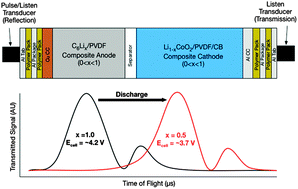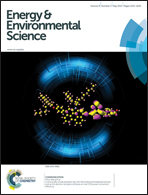Electrochemical-acoustic time of flight: in operando correlation of physical dynamics with battery charge and health†
Abstract
We demonstrate that a simple acoustic time-of-flight experiment can measure the state of charge and state of health of almost any closed battery. An acoustic conservation law model describing the state of charge of a standard battery is proposed, and experimental acoustic results verify the simulated trends; furthermore, a framework relating changes in sound speed, via density and modulus changes, to state of charge and state of health within a battery is discussed. Regardless of the chemistry, the distribution of density within a battery must change as a function of state of charge and, along with density, the bulk moduli of the anode and cathode changes as well. The shifts in density and modulus also change the acoustic attenuation in a battery. Experimental results indicating both state-of-charge determination and irreversible physical changes are presented for two of the most ubiquitous batteries in the world, the lithium-ion 18650 and the alkaline LR6 (AA). Overall, a one- or two-point acoustic measurement can be related to the interaction of a pressure wave at multiple discrete interfaces within a battery, which in turn provides insights into state of charge, state of health, and mechanical evolution/degradation.


 Please wait while we load your content...
Please wait while we load your content...